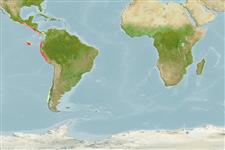Environment: milieu / climate zone / depth range / distribution range
Écologie
marin démersal; profondeur 35 - 600 m (Ref. 82251), usually 251 - 300 m (Ref. 82251). Subtropical; 24°N - 47°S, 107°W - 74°W
Eastern Pacific: distribution is not precisely known; but may extend from Mazatlán, Mexico to Chile.
Taille / Poids / Âge
Maturity: Lm ? range ? - ? cm
Common length : 35.0 cm TL mâle / non sexé; (Ref. 9330)
Épines dorsales (Total): 0; Rayons mous dorsaux (Total): 64-73; Épines anales 0; Rayons mous anaux: 52 - 58. Pectoral fins rather small, about 2 times in head in ocular side and about 2.5 times in head on blind side. Pelvic fin on ocular side slightly larger than on blind side. Caudal fin round. Body brownish, with obscure darker spots on body and fins (Ref. 27363).
This species inhabits soft bottoms (Ref. 9330); from the littoral zone (35 m, shallowest depth reported in Ref. 9330) up to 600 m (Yañez and Barbieri, 1974.in Ref. 82251:833). Common depth range was taken from a study done in northern Chile. Stomach contents include mainly the squat lobsters (Pleuroncodes monodon and Cervimunida johni) and the deep-sea shrimp (Heterocarpus reedi) (Ref. 82251). Exploited on a local level with trawl nets and is utilized fresh or as fishmeal.
Life cycle and mating behavior
Maturité | Reproduction | Frai | Œufs | Fécondité | Larves
Distinct pairing (Ref. 205).
Hensley, D.A., 1995. Paralichthyidae. Lenguados. p. 1349-1380. In W. Fischer, F. Krupp, W. Schneider, C. Sommer, K.E. Carpenter and V. Niem (eds.) Guia FAO para Identification de Especies para lo Fines de la Pesca. Pacifico Centro-Oriental. 3 Vols. FAO, Rome. (Ref. 9330)
Statut dans la liste rouge de l'IUCN (Ref. 130435)
Menace pour l'homme
Harmless
Utilisations par l'homme
Pêcheries: intérêt commercial mineur
Plus d'informations
Taille/ÂgeCroissanceLongueur-poidsLongueur-longueurFréquences de longueursMorphométrieMorphologieLarvesDynamique des populations larvairesRecrutementAbondanceBRUVS
RéférencesAquacultureProfil d'aquacultureSouchesGénétiqueElectrophoresesHéritabilitéPathologiesTraitementNutrientsMass conversion
Outils
Articles particuliers
Télécharger en XML
Sources Internet
Estimates based on models
Preferred temperature (Ref.
123201): 10.9 - 12, mean 11.4 °C (based on 7 cells).
Phylogenetic diversity index (Ref.
82804): PD
50 = 0.5078 [Uniqueness, from 0.5 = low to 2.0 = high].
Bayesian length-weight: a=0.00724 (0.00346 - 0.01519), b=3.17 (2.99 - 3.35), in cm total length, based on LWR estimates for this (Sub)family-body shape (Ref.
93245).
Niveau trophique (Ref.
69278): 3.7 ±0.3 se; based on diet studies.
Résilience (Ref.
120179): Haut, temps minimum de doublement de population inférieur à 15 mois (Preliminary K or Fecundity.).
Fishing Vulnerability (Ref.
59153): Low to moderate vulnerability (26 of 100).
Nutrients (Ref.
124155): Calcium = 461 [145, 1,393] mg/100g; Iron = 1.46 [0.59, 3.70] mg/100g; Protein = 16.2 [13.8, 18.5] %; Omega3 = 0.409 [0.142, 1.201] g/100g; Selenium = 14.4 [4.0, 51.4] μg/100g; VitaminA = 114 [18, 780] μg/100g; Zinc = 1.81 [0.93, 3.31] mg/100g (wet weight);
